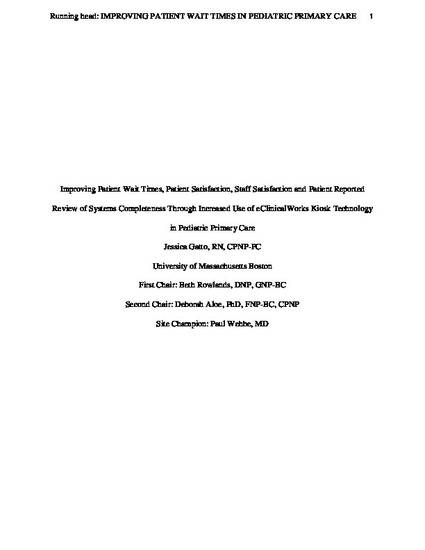
Other
Improving Patient Wait Times, Patient Satisfaction, Staff Satisfaction and Patient Reported Review of Systems Completeness Through Increased Use of eClinicalWorks Kiosk Technology in Pediatric Primary Care
(2018)
Abstract
Background: Timeliness of care is considered one of the core aspects to quality health care. Patient wait times that exceed 20 minutes may decrease the quality of care by decreasing patient satisfaction. Generally, previous quality improvement studies have been successful in reducing patient wait times and increasing patient satisfaction using a check-in kiosk.
Local Problem: Patient wait times in a pediatric primary care setting were found to exceed 20 minutes. Additionally, an existing check-in kiosk was not being utilized 100% of the time during the patient check-in process, potentially leading to longer total patient wait times and corresponding decreased patient satisfaction. The baseline data collected that identified the local problem included patient wait times, patient kiosk use rates, and ROS completeness.
Methods: Patient wait times, patient satisfaction surveys, kiosk use, and patient-entered ROS data were collected from two providers in weeks 1, 2, 4, and 5. Staff satisfaction surveys were collected in weeks 1 and 4. During week 3 staff education was implemented along with patient signage aimed towards directing patients to use the kiosk.
Implementation: The first component implemented was staff education and instructional materials that advised patients to use the kiosk during check in. The second component implemented included patient signage placed in the waiting room that advised patients to check in using the kiosk
Results: A 9 point increase in patient kiosk use was observed with a 60 second average decrease in patient wait time to the exam room, average wait to provider entrance in the exam room increased by 89 seconds, and the total average wait time increased 29 seconds. The kiosk was not effective in decreasing total average patient wait time. Overall, there was no change in patient satisfaction survey scores and staff satisfaction survey scores. ROS data entry remained high at 99% in weeks 1 and 2 and 94% in weeks 4 and 5.
Conclusion: The project implementation increased kiosk use rate marginally. The kiosk was ineffective as a quality improvement tool with respect to decreasing total average patient wait times. Additionally, the project was unable to improve patient satisfaction and staff satisfaction survey scores.
Keywords
- wait time,
- quality improvement,
- kiosk,
- pediatric,
- primary care,
- patient satisfaction,
- staff satisfaction
Disciplines
Publication Date
Spring April 29, 2018
Citation Information
Jessica Gatto. "Improving Patient Wait Times, Patient Satisfaction, Staff Satisfaction and Patient Reported Review of Systems Completeness Through Increased Use of eClinicalWorks Kiosk Technology in Pediatric Primary Care" (2018) Available at: http://works.bepress.com/jessica-gatto/1/